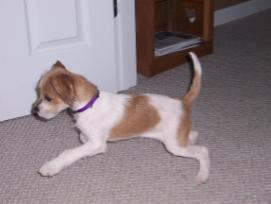
Tips
Jumping Dogs
Does your dog jump up on you or guests when you walk in the door? Dogs jump on people because it earns them attention. It's up to us to teach them that other, more appropriate behaviors earn that much needed/desired attention instead. Here are some ways to accomplish that:
1. Use management techniques to help give your dog time to calm down. Instead of allowing your dog free access to the doorway where you and guests enter, use a baby gate to restrict access. Give your dog time to calm down behind that gate before you or your guest greet him/her. Before your dog is allowed to greet your guest, put a leash on your dog so that if jumping is still attempted you can calmly lead your dog away until that burst of excitement subsides. Remember, no greeting should occur until your dog is calm with all 4 paws on the floor.
2. Reward behaviors that reinforce calm: sitting, laying down, standing with 4 paws on the floor. Ignore the behaviors that you don't want. If you come home to a dog that jumps all over the place, ignore him/her until you start to see the behavior(s) you prefer. You may need to fold your arms across your chest and turn your back to avoid inadvertently rewarding your dog with attention. When your dog stops jumping up, reward that "four on the floor" behavior with petting and plenty of calm attention. Remember: When your dog is jumping, do not touch, talk to or even look at him. For many dogs, this is a reward as it gives the attention s/he is seeking.
3. Be consistent! If jumping is sometimes allowed, not only will the behavior not stop, your dog may get better at it and be even more persistent. If you want your dog to learn "four on the floor" as a proper greeting behavior, you must practice it with EVERY greeting. Politely ask your guests to help with your dog's training by not providing attention to your dog unless s/he has four paws touching the floor.
4. Another option for training no jumping is to teach an alternate behavior. Teach your dog to sit instead of jump. If your dog is rewarded for sitting upon greeting a new guest or when you arrive home, s/he will learn to sit instead of jump. This alternative behavior should always earn praise, petting and attention. You may occasionally toss in a yummy food treat to show your dog how much this new behavior is appreciated.
5. Provide plenty of exercise and mental stimulation for your dog EVERY day. If you can take your dog for a nice walk around the neighborhood before your guests arrive, s/he will have burned off some of the extra energy. That should help your dog calm down much more quickly when your guest(s) arrives.
6. If you still need help teaching your dog not to jump on you or your guests, join us for obedience classes! We work on teaching your dog to take basic obedience skills and translate them into real life situations: polite door greetings, ignoring distractions that interfere with coming when called, ignoring distractions that get in the way of "stay" or loose-leash walking, etc. We'll have fun working with your dog and you will enjoy the benefits of a dog with obedience skills AND good manners in real life.
For more information, contact Laura Clawson, Certified Dog Trainer & Victoria Stilwell Positively Dog Trainer at (770) 871-8656 or visit www.unleashthepawsitive.com.
Getting A New
Family Dog This Year? Be Prepared!
Choosing a new dog
is a very important decision that you want to consider carefully. You want a pet that everyone in your family
will like as well as a dog that likes everyone in your family.
When choosing a dog, you have lots of options
and things to consider:
Will you get a
puppy or an adult dog?
If you choose a
puppy, are you prepared for training? There will be potty training, obedience training, and training the puppy
not to nip, bite, or chew on unacceptable things.
Who will let the
puppy out to go potty during the day?
Will you get your
dog from a shelter or rescue group, or will you research different breeds and
then find a reputable breeder to purchase from?
- If you choose to purchase your dog from a
breeder, do your homework and be prepared to ask a lot of questions, and always
ask to meet the parents of the puppies. Don’t be afraid to ask your questions. A good breeder will be very choosy about who they let purchase the puppies
and will ask you a lot of questions too.
What size dog is
right for your living situation? (For
example, a Labrador Retriever is not a good choice if you live in a small
apartment without a yard for the dog to run and play).
These are just of
the few of the things you should consider and research prior to bringing home
your new family dog.
In addition to
doing your homework on the logistics of getting a new dog, below are some
pointers when actually picking out a new puppy to bring home:
1.Look for puppies that are excited and happy to be around people. You want a puppy that enjoys being held and handled. If you are selecting a puppy from a breeder, look for a breeder who raises the puppies around people in an indoor environment where they get a lot of attention and who focus on early education and training.
2. Ask if the puppy is used to various household noises such as the clanging of pots and pans, vacuum cleaners, cars, closing doors, etc. Early exposure to these noises will help minimize the development of noise phobias as the puppy gets older.
3.Research the breed you are considering before going to look at the puppies. It’s too easy to fall in love with those cute faces and you want to make an educated decision about the type of dog you are purchasing.
4.Consider contacting a professional dog trainer to help you prepare for basic training and the ongoing socialization needs of your puppy. A good dog trainer will offer puppy classes to help you begin the training of your new puppy from the very beginning.
Good
luck with your search for a wonderful addition to your family!
For more information on choosing a new dog for your family, contact Laura Clawson at 770-871-8656 or via email at laura.clawson@unleashthepawsitive.com.
Be a Great Student at Dog Training Classes
1. Come prepared. If the trainer sends info before class, read it so you know what to bring, what time to arrive, etc.
2. Be Patient! Bad habits don't magically go away after a day. Don't think something isn't working just because the results aren't instant. Your dog is learning a whole new language!
3. Communicate with the trainer. If you're having difficulty, let the trainer know.
4. Practice! Training your dog requires time, repetition and patience. Do your homework between classes.
5. Come to classes with an open... mind and be willing to try new things, but never let a trainer talk you into using a technique or doing something to your dog that makes you uncomfortable.
6. Focus on your dog during training. Having conversations with people, using your cell phone, or entertaining kids (involve them in the training to make it easier) will only make you miss something important or make your dog lose focus too.
Are You Prepared for An Emergency?
With tornado season upon us, please don't forget to have an emergency plan that includes your pets. Put together a disaster supply kit that contains items you may need for your pet in case of emergency.
- Crate - one for each pet
- Food (include a manual can opener if you use canned food)
- Water
- Vaccination Records
- A collar with the ID & Rabies tags attached -Consider micro-chipping for added safety should your pet's collar be lost.
- Leash
- Pet First Aid Kit
- Veterinarian Contact Information
- Blankets
- Toys
- Towels and Grooming Supplies
- Medications
- A current photo of you and your pet(s) together

